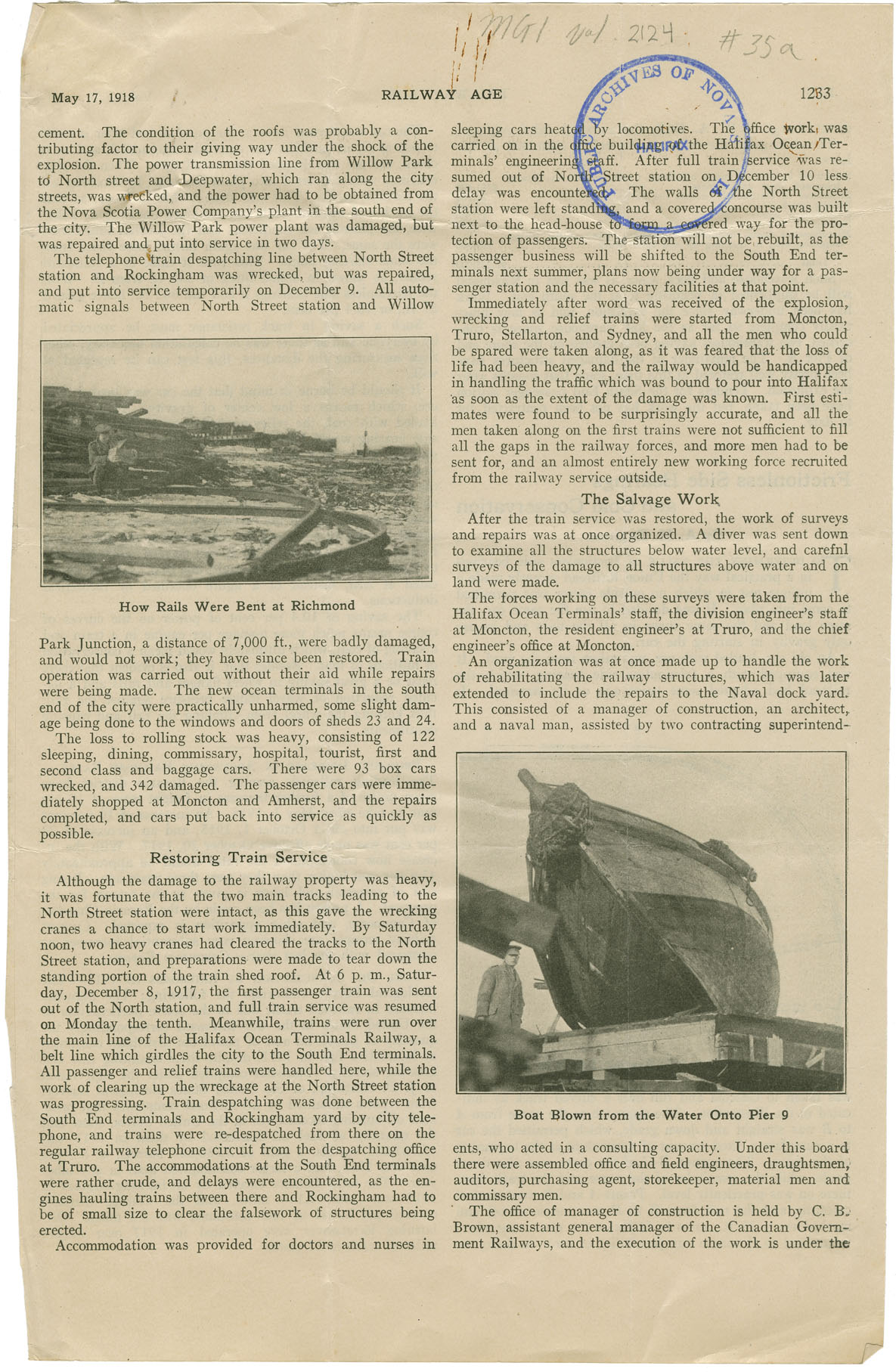Nova Scotia Archives
Archibald MacMechan
Halifax Disaster Record Office Materials
"Salvaging the Railway Facilities at Halifax, Nova Scotia", by F.B. Tapby in "Railway Age".
4 pages : 30 x 47 cm.
note: transcription publicly contributed - please contact us with comments, errors or omisions
cement. The condition of the roofs was probably a contributing factor to their giving way under the shock of the explosion. The power transmission line from Willow Park to North street and Deepwater, which ran along the city streets, was wrecked, and the power had to be obtained from the Nova Scotia Power Company's plant in the south end of the city. The Willow Park power plant was damaged, but was repaired and put into service in two days.
The telephone train despatching line between North Street station and Rockingham was wrecked, but was repaired, and put into service temporarily on December 9. All automatic signals between North Street station and Willow
[photo]
[caption]How Rails Were Bent at Richmond[caption]
Park Junction, a distance of 7,000 ft., were badly damaged, and would not work; they have since been restored. Train operation was carried out without their aid while repairs were being made. The new ocean terminals in the south end of the city were practically unharmed, some slight damage being done to the windows and doors of sheds 23 and 24.
The loss to rolling stock was heavy, consisting of 122 sleeping, dining, commissary, hospital, tourist, first and second class and baggage cars. There were 93 box cars wrecked, and 342 damaged. The passenger cars were immediately shopped at Moncton and Amherst, and the repairs completed, and cars put back into service as quickly as possible.
Restoring Train Service
Although the damage to the railway property was heavy, it was fortunate that the two main tracks leading to the North Street station were intact, as this gave the wrecking cranes a chance to start work immediately. By Saturday noon, two heavy cranes had cleared the tracks to the North Street station, and preparations were made to tear down the standing portion of the train shed roof. At 6 p. m., Saturday, December 8, 1917, the first passenger train was sent out of the North station, and full train service was resumed on Monday the tenth. Meanwhile, trains were run over the main line of the Halifax Ocean Terminals
Railway, a belt line which girdles the city to the South End terminals. All passenger and relief trains were handled here, while the work of clearing up the wreckage at the North Street station was progressing. Train despatching was done between the South End terminals and Rockingham yard by city telephone, and trains were re-despatched from there on the regular railway telephone circuit from the despatching office at Truro. The accommodations at the South End terminals were rather crude, and delays were encountered, as the engines hauling trains between there and Rockingham had to be of small size to clear the falsework of structures being erected.
Accommodation was provided for doctors and nurses in sleeping cars heated by locomotives. The office work was carried on in the office building of the Halifax Ocean Terminals' engineering staff. After full train service was resumed out of North Street station on December 10 less delay was encountered. The walls of the North Street station were left standing, and a covered concourse was built next to the head-house to form a covered way for the protection of passengers. The station will not be rebuilt, as the passenger business will be shifted to the South End terminals next summer, plans now being under way for a passenger station and the necessary facilities at that point. Immediately after word was received of the explosion, wrecking and relief trains were started from Moncton, Truro, Stellarton, and Sydney, and all the men who could be spared were taken along, as it was feared that the loss of life had been heavy, and the railway would be handicapped in handling the traffic which was bound to pour into Halifax as soon as the extent of the damage was known. First estimates were found to be surprisingly accurate, and all the men taken along on the first trains were not sufficient to fill all the gaps in the railway forces, and more men had to be sent for, and an almost entirely new working force recruited from the railway service outside.
The Salvage Work
After the train service was restored, the work of surveys and repairs was at once organized. A diver was sent down to examine all the structures below water level, and careful surveys of the damage to all structures above water and on land were made.
The forces working on these surveys were taken from the Halifax Ocean Terminals' staff, the division engineer's staff at Moncton, the resident engineer's at Truro, and the chief engineer's office at Moncton.
An organization was at once made up to handle the work of rehabilitating the railway structures, which was later extended to include the repairs to the Naval dock yard. This consisted of a manager of construction, an architect, and a naval man, assisted by two contracting superintend-
[photo]
[caption]Boat Blown from the Water Onto Pier 9[caption]
ents, who acted in a consulting capacity. Under this board there were assembled office and field engineers, draughtsmen, auditors, purchasing agent, storekeeper, material men and commissary men.
The office of manager of construction is held by C. B. Brown, assistant general manager of the Canadian Government Railways, and the execution of the work is under the
Reference: Archibald MacMechan Nova Scotia Archives MG 1 volume 2124 number 35

